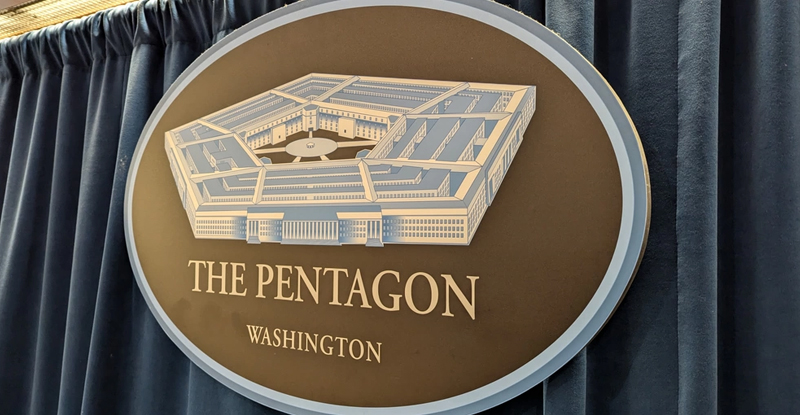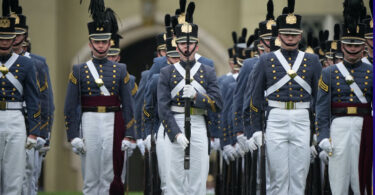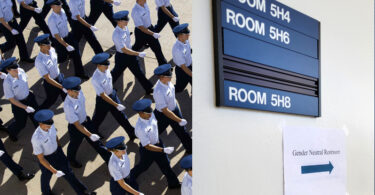By Will Thibeau, Army Ranger veteran
First published on Tom Klingenstein’s website. His Note: As observed at the outset of this series, a cold civil war is won or lost by the capture of institutions. Today, our Armed Forces are effectively captured by the group quota regime. Will Thibeau concludes his survey of the crisis by recommending a series of structural reforms designed to regain control over the institution itself, without which any attempts to combat wokeness in the ranks or at the Pentagon will be fruitless.
PART ONE | PART TWO | PART THREE
Part IV of Identity in the Trenches: The Fatal Impact of Diversity, Equity, and Inclusion on U.S. Military Readiness
If the United States Armed Forces are to become once again the envy of the world, it will be by returning to the rigorous standards and the ethics of individual and military excellence that once defined the culture in our ranks, from the newest enlistee to the highest ranks of the Pentagon.
To that end, the Department of Defense must end all consideration of race and sex in the evaluation of personnel, contracts, and programs.
So long as these factors are weighed, it is impossible for merit to win out.
At present, our military establishment is rife with quotas, “diversity goals,” and all manner of race and sex metrics that place identity over performance in the selection and training of personnel. Explicit reporting requirements are imposed to ensure compliance. Every one of these requirements must be eliminated.
New Pentagon leadership must also end the bias toward women inherent in the formation and application of contemporary military standards. Politics and ideology must be set aside entirely in the interest of developing an optimized fighting force. This means the military must measure men and women on the same scales of fitness, competence, and character, without exception.
At the very least, the Pentagon should review the combat readiness of gender-integrated units. Every serious study of the subject has indicated grave risks, suggesting that these units’ preparedness and capacity to fight is undermined by this latest transformation. The next administration has an obligation to update that literature, either confirming or revising those long-standing results.
As President Donald Trump discovered in his first term, however, the implementation of policy is contingent on an effective bureaucracy that follows the orders of politically accountable civilians.
To this end, a number of important structural reforms in the Pentagon should accompany targeted efforts to dismantle the DEI bureaucracy at the Department of Defense. Without these changes to how the military operates, even sound policy would be impossible to implement — and, therefore, meaningless.
Reforms to the Goldwater-Nichols Act of 1986
President Franklin D. Roosevelt established the Joint Chiefs of Staff (JCS) in 1942 to work with Great Britain’s combined chiefs of staff and serve as the president’s military advisors during World War Two. Post-war, the JCS assumed the role of military advisors to the president, dependent on unanimous consent.
In 1947, amid an intense post-war malaise and a perception of weakness, President Truman used the National Security Act to establish the position of Chairman of the Joint Chiefs of Staff (CJCS) to consolidate the advise-and-consent role of the Joint Chiefs and build military credibility. At the same time, the National Security Act brought the previously separate uniformed services together under the aegis of the DoD and the civilian leadership of the Secretary of Defense.
The increasing complexity of modern warfare, however, made inter-service frictions a major challenge as the new DoD began to operate. It was not until 1986 that Congress took major action to reduce that friction.
The Goldwater-Nichols Act represented the most substantial reforms to the DoD since its founding under the Truman administration. Among other changes, Goldwater-Nichols cut both the Joint Chiefs and the service secretaries out of the chain of command, while formally uniting the responsibilities and power of military advice in the single person of the chairman.
Section 3 of the Goldwater-Nichols Act states: “In enacting this Act, it is the intent of Congress, consistent with the congressional declaration of policy in section 2 of the National Security Act of 1947 (50 U.S.C. 401) — (1) to reorganize the Department of Defense and strengthen civilian authority in the Department.” The actual effect was quite the opposite, empowering and emboldening the Joint Staff at the expense of civilian leadership.
It is important to be clear about what the role of the CJCS, and by extension the entire Joint Staff, might include, while always understanding that nothing in law provides for the CJCS to wield decision-making power.
Under 10 U.S.C. § 163, which governs the chairman’s role, the president may “direct that communications between the President or the Secretary of Defense and the commanders of the … combatant commands be transmitted through the Chairman” and may “assign duties to the Chairman to assist the President and the Secretary of Defense in performing their command function.”
Additionally, “[t]he Secretary of Defense may assign to the Chairman … responsibility for overseeing the activities of the combatant commands,” although “[s]uch assignment by the Secretary to the Chairman does not confer any command authority on the Chairman[.]” The chairman also “serves as the spokesman for the commanders of the combatant commands especially on the operational requirements of their commands.”
The 2017 National Defense Authorization Act included new language concerning the Chairman of the Joint Chiefs of Staff. Under the new law, the chairman should be responsible “in matters relating to global military strategic and operational integration” and “advising the secretary on the allocation and transfer of forces among geographic and functional combatant commands” to address threats that exist across regions and arenas of war.
Congress is beginning to recognize the problem. The 2019 National Defense Strategy Commission’s final report stated that “civilian voices have been relatively muted on issues at the center of U.S. defense and national security policy, undermining the concept of civilian control,” and that “it is critical that DOD — and Congress — reverse the unhealthy trend in which decision-making is drifting away from civilian leaders on issues of national importance.”
In an effort to enhance civilian control of the military, the Goldwater-Nichols Act of 1986 marginalized politically appointed service secretaries by excising them from the operational chain of command. Although Congress simultaneously removed the JCS from that role, the establishment of the JCS as military advisors with specific “advise and consent” responsibilities in the chain of military decision making ensured they would retain increasing power, resources, and influence.
The president and Congress should clarify and circumscribe the role of the Joint Staff in operational warfighting. The Joint Staff, and the CJCS himself, should not serve as a bureaucratic commentariat on the details of current warfighting. They can synchronize with combatant commands on capabilities and provide that advice to the president but should not remain as a growing piece of the organizational chart themselves.
Much of the Joint Staff’s expansionism is baked into the letter of the law. Consider the job description of the Joint Staff Director:
In the joint arena, a body of senior flag or general officers assists in resolving matters that do not require JCS attention. Each Service Chief appoints an operations deputy who works with the Director, Joint Staff, to form the subsidiary body known as the Operations Deputies or the OPSDEPS. They meet in sessions chaired by the Director, Joint Staff, to consider issues of lesser importance or to review major issues before they reach the Joint Chiefs of Staff. With the exception of the Director, this body is not part of the Joint Staff. There is also a subsidiary body known as the Deputy Operations Deputies (DEPOPSDEPs), composed of the Vice Director, Joint Staff, and a two-star flag or general officer appointed by each Service Chief. Currently, the DEPOPSDEPs are the Service directors for plans. Issues come before the DEPOPSDEPs to be settled at their level or forwarded to the OPSDEPS. Except for the Vice Director, Joint Staff, the DEPOPSDEPs are not part of the Joint Staff.
This massive bureaucracy of high-ranking uniformed officers cannot possibly be justified for the Joint Staff to serve its intended purpose. In practice, even as Congress has gestured at limiting its powers, the Joint Staff has grown dramatically without any parallel increase in operating civilian authorities. It can hardly have happened otherwise when this is the legal structure Congress chose to set up.
Future conservative administrations should restrict the staff size of the Joint Staff to only those personnel assigned to the individual service chiefs themselves.
With this still-significant staff, service chiefs would be well equipped to fulfill their statutory role: advising the JCS, SECDEF, and president on military matters. The responsibilities that merit DEPOPSDEPs and other extensive bureaucratic operations should fall under the purview of service secretaries themselves.
During World War II, there was one officer for every 6,000 troops. In 2017, there was one officer for every 1,400 troops.
Even Secretary Gates’s 2017 NDAA Reduction of General Officers only reduced the total number by 5%. This explosion in numbers can be explained in large part by a bureaucratic bloat among uniformed personnel that is overtaking responsibilities rightly held by civilian leadership.
Reforming Goldwater-Nichols to clarify lines of authority will strengthen civilian control and help ensure appropriate oversight and accountability. This oversight is absolutely essential to any effort at reform.
Accountability for General Officers
The president’s authority to appoint and remove military officers is derived from Article II, Section 2 of the United States Constitution, which designates the president as the commander-in-chief of the Armed Forces.
Last century, this power was affirmed in practice when Congress examined President Harry S. Truman’s controversial decision to relieve General Douglas MacArthur of his duties and determined it to be “within the constitutional power of the President.” Article II fully and exclusively grants the president broad powers to command and control the military, including the authority to appoint and remove officers to ensure the effective execution of military operations and the defense of the nation.
Three- and four-star generals only hold those grades when they are designated as filling roles of “importance and responsibility.” If the president terminates a three- or four-star assignment and the general does not apply for voluntary assignment, he will revert back to a two-star rank. If a former three- or four-star general is relieved from his position and reverts to the lower general rank and still refuses to request retirement, the president may be able to dismiss the officer from the Armed Forces entirely.
Presidents have been wary of exercising these powers, and understandably so. Politicians, even commanders-in-chief, are fearful of the perception that they are working to politicize the military.
Given our extraordinary challenges, however, the full extent of the president’s constitutional authority will be required to roll back such politicization. Three- and four-star ranks can no longer be viewed as sacrosanct, and even the highest-ranking officers must understand themselves as serving wholly under the constitutional authority of the elected commander-in-chief.
Any president who is serious about reform must be willing to enforce accountability among general officers. Those who refuse to recommit to a merit-first service, or those who prove unable to do so, are not entitled to extra-constitutional privileges.
What Tuberville Taught Us
In 2023, Senator Tommy Tuberville of Alabama placed a hold on all general officer military promotions over Secretary Austin’s decision to use public money for service members’ and dependents’ abortion-related expenses. While Tuberville eventually backed down, his stand provided a crucial opportunity to examine the political state of our military leadership.
Research findings revealed concerning trends regarding the politicization of service and the conduct of senior officers.
Firstly, the research indicated that a significant portion of military officers, over 44%, engaged in behaviors that politicized their service in objectionable ways.
These included controversial tweets from social media accounts that carried an identification of the user as a uniformed military officer, speeches at PRIDE or Equality Day events, Women’s Equality Day presentations, and op-eds about “systemic racism.”
Research also identified 3-4 dozen senior officers whose public conduct was deemed worthy of termination. These officers exhibited behavior or actions that were deemed inappropriate, unethical, or incompatible with the standards of conduct expected of military leaders.
Admiral Shoshana Chatfield, for instance, publicly insisted that service members should be skeptical of laws from Congress because so many representatives and Senators are white men.
Republicans and Democrats have defended this conduct by explaining the duty of military officers to follow the orders of politically appointed officials. That call for understanding is warranted, but it misses the mark.
While uniformed officers must implement policy and follow orders, they are not required to be — and, in fact, must not be — parrots of the political ideology of civilian leaders.
The tradition of military officership was borne of an absolutely apolitical class of professionals. Leading generals such as William T. Sherman and “Black Jack” Pershing considered it absurd for officers to vote in American elections.
As Samuel P. Huntington argues in his The Soldier and the State, if the American military is to recover from the present crisis, it must recover a sense of the profession removed from the “politics and ideologies” of the prevailing culture.
Of course, military leaders must not be ignorant of other, more political domains like diplomacy and economics. But they must be resolutely focused on and grounded in the military profession that undergirds U.S. grand strategy.
The only way to ensure this focus is to restore fully the constitutional mandate of civilian control.
That restoration in turn will empower a motivated commander-in-chief to clean house in the Pentagon, and to reorient our Armed Forces around the singular standard of professional excellence.
This roadmap, if followed carefully, could save our military and our nation from a far greater crisis when the next conflict arrives.








Leave a Comment